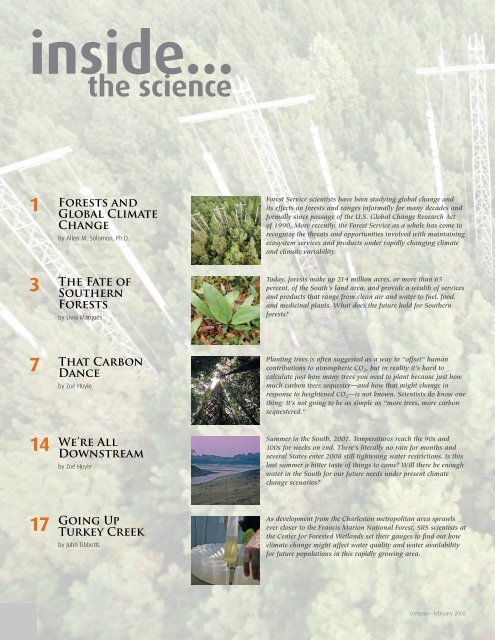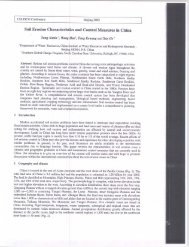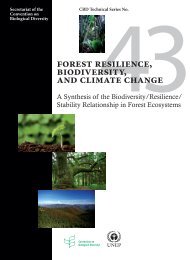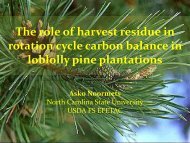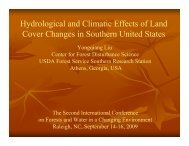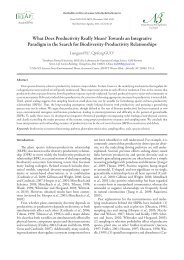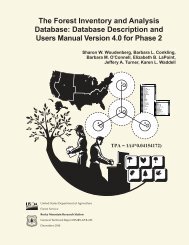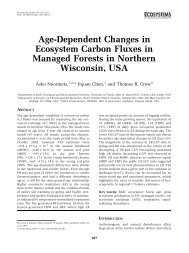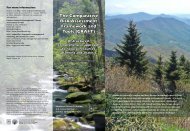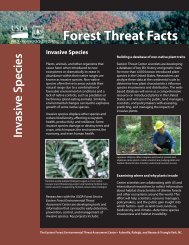What do forests have to do with global climate change? What do ...
What do forests have to do with global climate change? What do ...
What do forests have to do with global climate change? What do ...
You also want an ePaper? Increase the reach of your titles
YUMPU automatically turns print PDFs into web optimized ePapers that Google loves.
2<br />
inside...<br />
the science<br />
1<br />
3<br />
7<br />
14<br />
17<br />
Forests and<br />
Global Climate<br />
Change<br />
by Allen M. Solomon, Ph.D.<br />
The Fate of<br />
Southern<br />
Forests<br />
by Livia Marqués<br />
That Carbon<br />
Dance<br />
by Zoë Hoyle<br />
We’re All<br />
Downstream<br />
by Zoë Hoyle<br />
Going Up<br />
Turkey Creek<br />
by John Tibbetts<br />
Forest Service scientists <strong>have</strong> been studying <strong>global</strong> <strong>change</strong> and<br />
its effects on <strong>forests</strong> and ranges informally for many decades and<br />
formally since passage of the U.S. Global Change Research Act<br />
of 1990. More recently, the Forest Service as a whole has come <strong>to</strong><br />
recognize the threats and opportunities involved <strong>with</strong> maintaining<br />
ecosystem services and products under rapidly changing <strong>climate</strong><br />
and <strong>climate</strong> variability.<br />
Today, <strong>forests</strong> make up 214 million acres, or more than 65<br />
percent, of the South’s land area, and provide a wealth of services<br />
and products that range from clean air and water <strong>to</strong> fuel, food,<br />
and medicinal plants. <strong>What</strong> <strong>do</strong>es the future hold for Southern<br />
<strong>forests</strong>?<br />
Planting trees is often suggested as a way <strong>to</strong> “offset” human<br />
contributions <strong>to</strong> atmospheric CO 2, but in reality it’s hard <strong>to</strong><br />
calculate just how many trees you need <strong>to</strong> plant because just how<br />
much carbon trees sequester—and how that might <strong>change</strong> in<br />
response <strong>to</strong> heightened CO 2—is not known. Scientists <strong>do</strong> know one<br />
thing: It’s not going <strong>to</strong> be as simple as “more trees, more carbon<br />
sequestered.”<br />
Summer in the South, 2007. Temperatures reach the 90s and<br />
100s for weeks on end. There’s literally no rain for months and<br />
several States enter 2008 still tightening water restrictions. Is this<br />
last summer a bitter taste of things <strong>to</strong> come? Will there be enough<br />
water in the South for our future needs under present <strong>climate</strong><br />
<strong>change</strong> scenarios?<br />
As development from the Charles<strong>to</strong>n metropolitan area sprawls<br />
ever closer <strong>to</strong> the Francis Marion National Forest, SRS scientists at<br />
the Center for Forested Wetlands set their gauges <strong>to</strong> find out how<br />
<strong>climate</strong> <strong>change</strong> might affect water quality and water availability<br />
for future populations in this rapidly growing area.<br />
compass—february 2008


